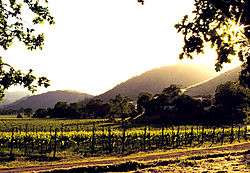Calistoga AVA
| Wine region | |
 Vines at Chateau Montelena in Calistoga | |
| Type | American Viticultural Area |
|---|---|
| Year established | 2010[1] |
| Country | United States |
| Part of | Napa Valley AVA |
| Other regions in Napa Valley AVA | Atlas Peak AVA, Chiles Valley AVA, Diamond Mountain District AVA, Howell Mountain AVA, Los Carneros AVA, Mt. Veeder AVA, Coombsville AVA, Oak Knoll District of Napa Valley AVA, Oakville AVA, Rutherford AVA, Spring Mountain District AVA, St. Helena AVA, Stags Leap District AVA, Wild Horse Valley AVA, Yountville AVA |
| Climate region | III[2] |
| Precipitation (annual average) | 38 inches (97 cm) to 60 inches (150 cm) annually[3] |
| Total area | approximately 7 square miles (18 km2)[4] |
| Varietals produced | Cabernet Sauvignon, Petite Sirah, Syrah, Zinfandel, Cabernet Franc[3] |
| No. of wineries | 24[4] |
The Calistoga AVA is an American Viticultural Area located in the northern portion of California's Napa Valley AVA. The appellation is distinguished by its volcanic soil,[3] high temperatures up to 100 °F (38 °C) during the day, and cool nights during the growing season due to breezes from the Russian River, causing the highest diurnal temperature variation in the Napa Valley—up to 50 °F (28 °C).[4]
Geography and Climate
Despite sharing a name, the Calistoga AVA does not encompass the entirety of the town of Calistoga. The area is noted for its topographical diversity and uniform geology, with bedrock almost exclusively made through volcanic action. The hot days provide color and flavor in the wines, while the cool nights help to maintain acidity and structure[4]
The appellation abuts the Diamond Mountain District AVA to the south and west, the Saint Helena AVA to the southeast, and the Howell Mountain AVA is a short way to the east.
History
The name Calistoga dates back to 1857, with the first vine plantings in 1862. Viticultural and winery census data from 1880 list Calistoga as a distinct region separate from Napa.[5] The appellation was proposed in 2003 by Bo Barrett petitioning for separate AVA status, with final approval coming through in 2009, effective 2010.[6]
Controversy
When the appellation was proposed, two wineries (Calistoga Cellars and Calistoga Estate) fought against the proposal, as under U.S. wine law they would either have to use 85% grapes from the new AVA (neither did at the time) or change their brand names.[6] Several compromises were proposed, and ultimately rejected, before the AVA was approved. During the process, the Tax and Trade Bureau, the federal body in charge of AVA designations, paused the process of all AVA proposals due to the need to redefine regulations.[7]
Ultimately, the wineries using the Calistoga name were given three years to come in compliance with the appellation rules or discontinue using the name.[8]
See also
References
- ↑ Code of Federal Regulations. "§ 9.209 Calistoga." Title 27: Alcohol, Tobacco and Firearms; Part 9 — American Viticultural Areas; Subpart C — Approved American Viticultural Areas. Retrieved June 24, 2011.
- ↑ Ahern, Jayson (8 December 2009). Federal Register (PDF). 74 (234): 64604 http://edocket.access.gpo.gov/2009/pdf/E9-29217.pdf. Retrieved 24 June 2011. Missing or empty
|title=(help) - 1 2 3 "Napa Valley Appellations and Wine Growing Regions". Napa Valley Vintners. Retrieved 24 June 2011.
- 1 2 3 4 SteveLay. "Newest AVA-Do you buy wines based upon an AVA?-Calistoga AVA". Retrieved 24 June 2011.
- ↑ Sullivan, Charles L (1994). Napa Wine: A History from Mission Days to Present. Wine Appreciation Guild. ISBN 978-0-932664-70-9.
- 1 2 Gordon, Jim. "Contested Calistoga AVA Approved". Wines & Vines. Retrieved 24 June 2011.
- ↑ Goldfarb, Alan (9 August 2007). "The Big Freeze: Money and Politics Stop AVA Petitions in Their Tracks". Appellation America. Retrieved 24 June 2011.
- ↑ Quackenbush, Jeff (14 Dec 2009). "'Grandfathered' date still issue for Calistoga AVA". North Bay Business Journal. Retrieved 24 June 2011.